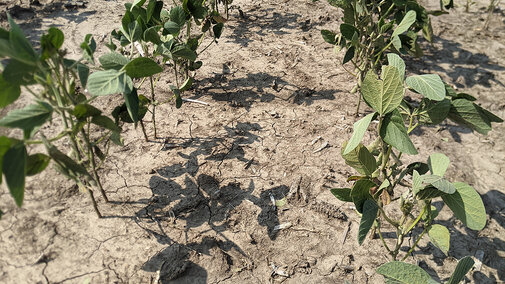With drought plaguing parts of Nebraska this year, producers may want to salvage soybeans as forage instead of for grain. Many can remember when soybeans were only used for forage many decades ago, so it can definitely be done.
Brown soybean plants that were evaluated by crop insurance at 2-4 bu/ac can be grazed if a grower doesn’t wish to harvest them. They’re just low quality.
Grazing, haying or ensiling can all be done with soybean plants. Grazing is very simple and has a relatively low risk of bloat; however, if there are many bean seeds themselves, high oil consumption can cause issues in cattle, especially calves. Young calves should not be allowed access to beans. We typically shoot for less than 7% of the diet as the bean. So with cows that is about 2 lb per day (that’s under “normal” situations with beans at 20% fat and we assume some of these beans may have less oil). We’re guessing cattle will pre-select pods/seeds. Allocation/limiting access is one way to handle this. Providing palatable hay or another feed may also reduce the likelihood of cattle overeating soybeans. Use strip grazing to force the use of the entire plant.
Hay from soybeans will have a similar quality to that of alfalfa. However, drying and rolling up hay is difficult with soybeans. The leaves become very fragile, while the stems can take a long time to dry. Crimp the stem heavily and resist the urge to rake the windrow unless done only one day after cutting to limit leaf shatter.
Soybean silage is easier than haying. The moisture content needs to be between 60% and 70%. In the past, soybean silage has been packing while corn silage is being packed at a ratio of one ton soybean silage to three or four tons corn silage. This improves fermentation and will make the overall silage pile have higher crude protein. If doing only soybean silage in a pile, wait until the leaves begin to turn yellow and be sure to use an inoculant. Adding a bushel of rolled corn per ton of silage can help fermentation, and as always, be sure to get a very good pack.
Using soybeans other than for grain can be done. Remember to have the soybeans released by crop insurance prior to using for forage. We’ve been told that many soybeans aren’t being released until the plants turn completely brown. However, please ask your insurance if you can leave strips for them to assess later. As the plant matures, the stems basically become so low quality, they are like sawdust in feed value. So using now is a good idea in situations where one can get them released.
One final important thing is not to provide access to blocks, tubs or supplements that contain urea when allowing access to raw soybeans. Raw soybeans contain urease that can rapidly turn urea into ammonia and cause ammonia toxicity.

